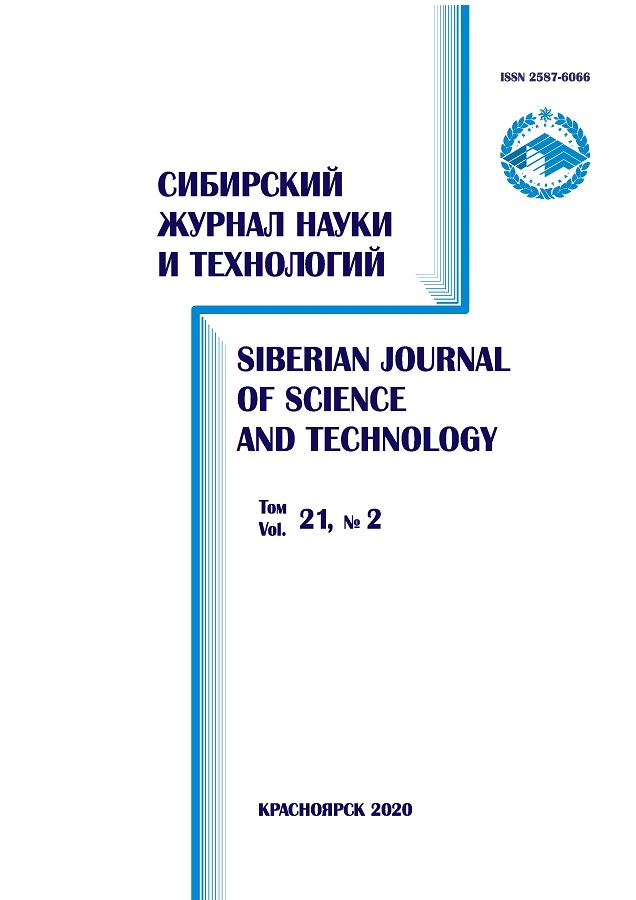The process of nanomodifying cast aluminum alloy ingots for components of aerospace vehicles
- Авторлар: Krushenko G.G.1,2, Nazarov V.P.2, Reshetnikova S.N.2, Dvirnyy G.V.2
-
Мекемелер:
- Institute of computational modeling SB RAS
- Reshetnev Siberian State University of Science and Technology
- Шығарылым: Том 21, № 2 (2020)
- Беттер: 268-276
- Бөлім: Section 3. Technological Processes and Materials
- ##submission.datePublished##: 22.10.2023
- URL: https://journals.eco-vector.com/2712-8970/article/view/611140
- DOI: https://doi.org/10.31772/2587-6066-2019-20-2-268-276
- ID: 611140
Дәйексөз келтіру
Толық мәтін
Аннотация
Currently, increasing attention has been paid to such a class of materials as nanopowders (NP) of chemical compounds, which are ultra-thin formations of not more than 100 nm in size. Such attitude to these materials is explained by the fact that they have unique physical, chemical and mechanical properties significantly different from the properties of materials of the same chemical composition in a massive state, and these properties can be transferred to some extent from them or with their participation to the products.
The existing methods of introducing NP into metal melts could not be used due to their special properties in comparison with coarse powders, and therefore a new method of their introduction into the melt was developed, excluding direct contact of NP particles with oxygen and unhindered penetration of particles into the melt through the oxide layer. The essence of the method was as follows. In the aluminum container filled up with aluminum particles or deformable aluminum alloys D1 or D16 and various NP (nitrides, carbides, oxides, etc.), and this composition was pressed into the rod, with its help NP was introduced into the melt during casting of aluminum ingots and deformable aluminum alloys.
The results of the study showed that this excludes the appearance of cracks in the ingots, as well as improves their technological and mechanical properties.
Авторлар туралы
Genrikh Krushenko
Institute of computational modeling SB RAS; Reshetnev Siberian State University of Science and Technology
Хат алмасуға жауапты Автор.
Email: genry@icm.krasn.ru
Dr. Sc., Prof., Ch. Researcher; Professor
Ресей, 44, Akademgorodok, Krasnoyarsk, 660036; 31, Krasnoyarsky Rabochy Av., Krasnoyarsk, 660037Vladimir Nazarov
Reshetnev Siberian State University of Science and Technology
Email: nazarov@sibsau.ru
Ph. D., Professor, Department of Aircraft Engines
Ресей, 31, Krasnoyarsky Rabochy Av., Krasnoyarsk, 660037Svetlana Reshetnikova
Reshetnev Siberian State University of Science and Technology
Email: ambre2014650@yandex.ru
Cand. Sc., Head of Methodical study of dissertation councils
Ресей, 31, Krasnoyarsky Rabochy Av., Krasnoyarsk, 660037Guriy Dvirnyy
Reshetnev Siberian State University of Science and Technology
Email: dg1802@mail.ru
Cand. Sc., Associate Professor of the Department “Mechanical Engineering”
Ресей, 31, Krasnoyarsky Rabochy Av., Krasnoyarsk, 660037Әдебиет тізімі
- Moskvichev V. V., Krushenko G. G., Burov A. E. et al. Nanopoproshkovye tekhnologii v mashinostroenii. [Nanoporoshkov engineering technologies]. Krasnoyarsk, Sibirskiy federal'nyy universitet Publ., 2013, 186 p.
- Gusev A. I. [Effects of the nanocrystalline state in compact metals and their compounds]. UFN. 1998, Vol. 168, No. 1, P. 55–83 (In Russ.).
- Krushenko G. G. [History, status and prospects of nanotechnology development]. Nanotekhnika. 2006, No. 4, P. 16–22 (In Russ.).
- Rouvray D. H. Is the future nano? Chemistry in Britain. 2000, No.12, P. 27–32.
- Feynman R. P. There’s plenty of room at the bottom. Engineering and Science. 1960, Vol. 23, No. 2, P. 22–36.
- Drexler K. E. Molecular engineering:An approach to the development of general capabilities for molecular manipulation. Proceedings of the National Academy of Sciences. 1981, Vol. 78, No. 9, P. 5275–5278.
- Drexler K. E. Engines of Creation: The Coming Era of Nanotechnology. New York, Anchor-Doubleday, 1986, 298 p.
- Nanotechnology. Integrated Processing Systems for Ultra-Precision and Ultra-Fine Products, Ed. Taniguchi N. Oxford: Oxford University Press, 1996, 406 p.
- Taniguchi N. On the Basic Concept of NanoTech-nology. Proc. Intern. Conf. Prod. Eng. Tokyo: Part II, Japan Society of Precision Engineering, 1974. P. 18–23.
- Visser G. W. Nanotechnology, what is it? Sixth Session. Forum VI, Plenary Session Nanotechnology and manufactured nanomaterials: opportunities and challenges. Le Meridien President, Dakar, Senegal. Available at: http:// lenta.ru/articles/2008/05/16/nano/ (accesed 04.07.2018).
- Saburov V. P., Cherepanov A. N., Krushenko G. G. et al. Plazmokhimicheskiy sintez ul'tradispersnykh poroshkov i ikh primenenie dlya modifitsirovaniya metallov i splavov [Plasma chemical synthesis of ultrafine powders and their application for modification of metals and alloys]. Novosibirsk, Nauka Publ., 1995, 344 p.
- Zhukov M. F., Cherskiy I. N., Krushenko G. G. et al. Uprochnenie metallicheskikh, polimernykh i elastomernykh materialov ul'tradispersnymi poroshkami plazmokhimicheskogo sinteza [Hardening of metal, polymer and elastomeric materials by ultrafine powders of plasma chemical synthesis]. Novosibirsk, Nauka Publ., 1999, 312 p.
- Moskvichev V. V., Makhutov N. A., Krushenko G. G. et al. Treshchinostoykost' i mekhanicheskie svoystva konstruktsionnykh materialov tekhnicheskikh system [Crack resistance and mechanical properties of structural materials of technical systems]. Novosibirsk, Nauka Publ., 2002, 234 p.
- Krushenko G. G., Musokhranov Yu. M., Yamskikh I. S. et al. Sposob modifitsirovaniya liteynykh alyuminievykh splavov evtekticheskogo tipa [Method of modification of casting aluminum alloys of eutectic type]. Patent SU, no. 831840, 1981.
- Krushenko G. G., Padalka V. A., Ryabinko A. V. et al. [Atlas of casting defects of ingots made of aluminum and aluminum deformable alloys, cast by semicontinuous method]. Tsvetnaya metallurgiya. 1998, No. 11–12, P. 42 (In Russ.).
- Dobatkin V. I. Slitki alyuminievykh splavov. [Ingots of aluminum alloys]. Moscow, Metallurgizdat Publ., 1960, 176 p.
- Goly-Probst A., Sturmer U. Increased caster productivity with the B. O. P. S. breakout prediction system. Metals, Mining & More. 2000, No. 3, P. 6.
- Krushenko G. G., Terekhov V. N., Kuznetsov A. N. [Continuous casting of ingots with the use of molten aluminum and alloys]. Tsvetnye metally. 1975, No. 11, P. 49–51 (In Russ.).
- Ezekiel M., Fox K. A. Methods of correlation and regression. New York: Wiley, 1963. 562 p.
- Krushenko G. G., Kuznetsov A. N. [Reduction of aluminum ingot scrap on cracks when working on liquid charge]. Tsvetnye metally. 1976, No. 5, P. 52–53 (In Russ.).
Қосымша файлдар









